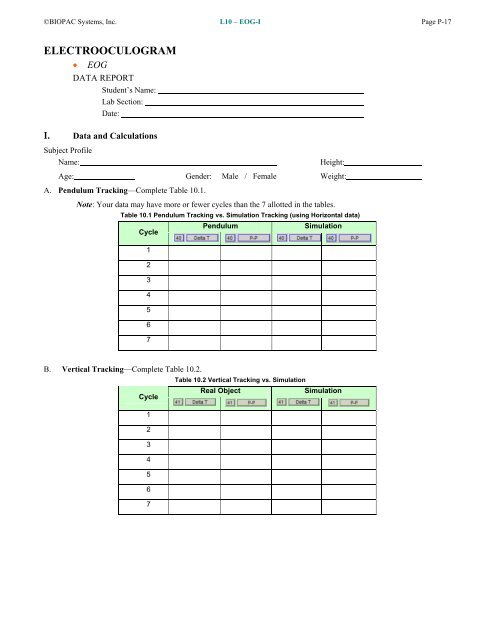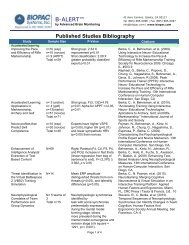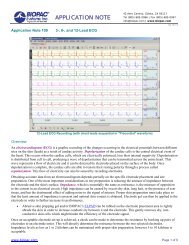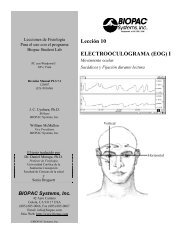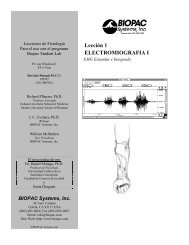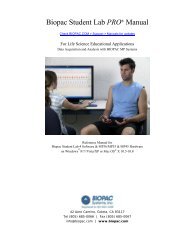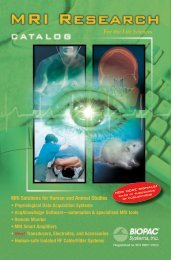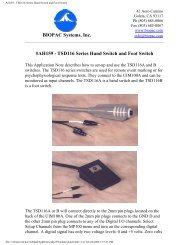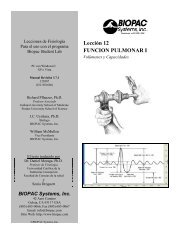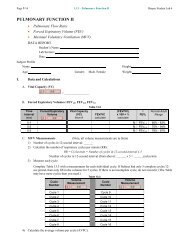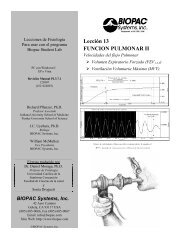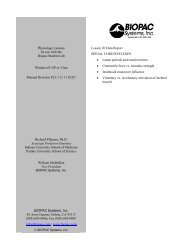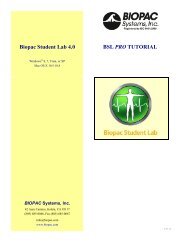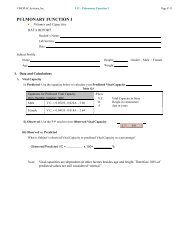Lesson 10 Data Report - Biopac
Lesson 10 Data Report - Biopac
Lesson 10 Data Report - Biopac
Create successful ePaper yourself
Turn your PDF publications into a flip-book with our unique Google optimized e-Paper software.
©BIOPAC Systems, Inc. L<strong>10</strong> – EOG-I Page P-17<br />
ELECTROOCULOGRAM<br />
EOG<br />
DATA REPORT<br />
Student’s Name:<br />
Lab Section:<br />
Date:<br />
I. <strong>Data</strong> and Calculations<br />
Subject Profile<br />
Name:<br />
Height:<br />
Age: Gender: Male / Female Weight:<br />
A. Pendulum Tracking—Complete Table <strong>10</strong>.1.<br />
Note: Your data may have more or fewer cycles than the 7 allotted in the tables.<br />
Table <strong>10</strong>.1 Pendulum Tracking vs. Simulation Tracking (using Horizontal data)<br />
Cycle<br />
1<br />
2<br />
3<br />
4<br />
5<br />
6<br />
7<br />
Pendulum<br />
Simulation<br />
B. Vertical Tracking—Complete Table <strong>10</strong>.2.<br />
Table <strong>10</strong>.2 Vertical Tracking vs. Simulation<br />
Cycle<br />
1<br />
2<br />
3<br />
4<br />
5<br />
6<br />
Real Object<br />
Simulation<br />
7
Page P-18 L<strong>10</strong> – EOG-I <strong>Biopac</strong> Student Lab 4<br />
C. Saccades—Complete Table <strong>10</strong>.3.<br />
Table <strong>10</strong>.3 Saccades<br />
Measurement<br />
Read Silently 1<br />
1 st line 2 nd line<br />
Read Silently 2<br />
1 st line 2 nd line<br />
Read Aloud<br />
1 st line 2 nd line<br />
Number of words<br />
Number of saccades<br />
Time interval between<br />
saccades<br />
#1<br />
#2<br />
#3<br />
#4<br />
#5<br />
#6<br />
#7<br />
#8<br />
#9<br />
Average time interval<br />
between saccades<br />
(Calculate)<br />
II.<br />
Questions<br />
D. Focusing a camera changes the distance between the lens and the film. Does the eye focus by changing the distance<br />
between the lens and the retina? Explain your answer.<br />
__________________________________________________________________________________________<br />
__________________________________________________________________________________________<br />
E. Define the following terms:<br />
Cone<br />
Rod<br />
Fovea<br />
Visual Field<br />
Visual Fixation<br />
Saccade / Microsaccade<br />
F. Why is vision in darkness more effective when focusing away from the fovea rather than focusing directly on the fovea?
©BIOPAC Systems, Inc. L<strong>10</strong> – EOG-I Page P-19<br />
G. Explain the difference between “voluntary fixation” and “involuntary fixation”:<br />
H. Examine the data in Table <strong>10</strong>.1 and answer the following questions<br />
a.) Did the amplitude continue to decrease with each successive swing cycle during pendulum tracking? Explain<br />
b.) Did the amplitude continue to decrease with each successive swing cycle during simulated pendulum tracking?<br />
Explain<br />
c.) Did the time interval (period) of each successive swing cycle increase, decrease, or remain constant during<br />
pendulum movement? Explain<br />
d.) Did the time interval (period) of each successive swing cycle increase, decrease, or remain constant during<br />
simulated movement? Explain<br />
e.) Are the waveform shapes different between tracking and simulated tracking data? Explain<br />
I. Examine the data in Table <strong>10</strong>.2 and answer the following questions:<br />
a.) Do the cycle amplitudes increase, decrease, or remain constant during vertical tracking? Explain<br />
______________________________________________________________________________________<br />
b.) Do the cycle amplitudes increase, decrease, or remain constant during simulated vertical tracking? Explain<br />
______________________________________________________________________________________<br />
c.) Do the cycle periods increase, decrease, or remain constant during vertical tracking? Explain<br />
______________________________________________________________________________________<br />
d.) Do the cycle periods increase, decrease, or remain constant during simulated vertical tracking? Explain<br />
______________________________________________________________________________________<br />
e.) Are the waveform shapes different between vertical tracking and simulated vertical tracking data? Explain<br />
______________________________________________________________________________________<br />
J. Examine the data in Table <strong>10</strong>.3 and answer the following questions:<br />
a.) Did the number of saccades match the number of words for each line? Explain any differences.<br />
______________________________________________________________________________________
Page P-20 L<strong>10</strong> – EOG-I <strong>Biopac</strong> Student Lab 4<br />
b.) Is the average time interval between saccades different when reading an easy passage vs. a challenging passage?<br />
Explain<br />
c.) Is the average time interval between saccades different when reading the same passage silently vs. aloud?<br />
________________________________________________________________________________________<br />
d.) Are the waveform shapes different between Read Silently 2 and Read Aloud data? Explain<br />
_________________________________________________________________________________________<br />
K. Name the cranial nerves tested and the extraocular muscles tested when the subject is asked to follow the eraser on a<br />
pencil when moved in a one foot circle, two feet from face.<br />
Cranial Nerves<br />
Extraocular Muscles<br />
L. Define corneal–retinal potential (CRP) and explain its relation to electrooculography and the electrooculogram.<br />
_____________________________________________________________________________________________<br />
_____________________________________________________________________________________________<br />
_____________________________________________________________________________________________<br />
_____________________________________________________________________________________________<br />
________________________________________________________________________________________
©BIOPAC Systems, Inc. L<strong>10</strong> – EOG-I Page P-21<br />
III. OPTIONAL Active Learning Portion<br />
A. Hypothesis<br />
B. Materials<br />
C. Method<br />
D. Set Up<br />
E. Experimental Results<br />
End of <strong>Lesson</strong> <strong>10</strong> <strong>Data</strong> <strong>Report</strong>
Page P-22 L<strong>10</strong> – EOG-I <strong>Biopac</strong> Student Lab 4<br />
Sample Readings<br />
Easy:<br />
You put your right foot in, you put your<br />
right foot out, you put your right foot in<br />
and you shake it all about. You do the<br />
Hokey Pokey and you turn yourself around,<br />
that’s what it’s all about!<br />
Difficult:<br />
O proud left foot, that ventures quick<br />
within, then soon upon a backward journey<br />
lithe. Anon, once more the gesture, then<br />
begin: Command sinistral pedestal to<br />
writhe. Commence thou then the fervid<br />
Hokey Poke. A mad gyration, hips in wanton<br />
swirl. To spin! A wilde release from<br />
heaven’s yoke, Blessed dervish! Surely<br />
canst go, girl. The Hoke, the Poke –<br />
banish now thy doubt. Verily, I say, ‘tis<br />
what it’s all about.


